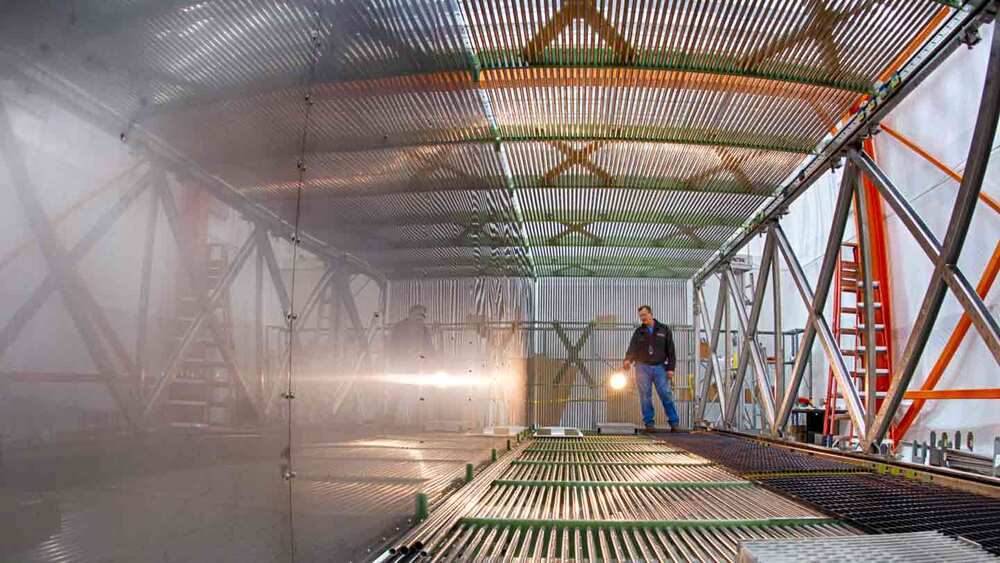Facebook has been putting research into systems that will see, hear, and remember everyday activities and interactions on AR/VR devices.




The emission-free aircraft will carry up to 76 passengers.
A new aviation partnership could see commercial hydrogen-electric airliners take to the skies. The parent company of Alaska Airlines, Alaska Air Group, is partnering with zero-emission aviation firm ZeroAvia to develop a hydrogen-electric powertrain for a 76-seater passenger airliner, a press statement reveals.
The two companies say that their ZA2000 hydrogen-electric powertrain will have a power output of 2,000–5,000 kW and a range of 500 miles (804 km). The powertrain will initially be fitted into a full-size De Havilland Q400 aircraft. Alaska Air also announced it has invested in ZeroAvia with a view to helping it meet its goal of net-zero emissions by 2040.
To keep up with China and Russia. The future of warfare builds on previous successes. And throughout conflicts in Iraq, Syria, and Afghanistan, the U.S. military possessed an unrivaled advantage in air superiority. But all things change, and to face the possibility of conflict with new and advanced weapons and aircraft from Russia or China, the Special Operations Command (SOCOM) wants to upgrade some of its largest aircraft with cruise missiles, according to a recent solicitation shared on a government website. Specifically, SOCOM’s plans call for equipping AC-130s with cruise missiles, in addition to transforming the MC-130 into a \.
Equipping AC-130s with cruise missiles could prove superfluous.
Unlike the hypersonic missiles that major powers are developing like a second arms race, cruise missiles are a kind of munitions that move at subsonic speeds and fly at low altitudes, increasing the difficulty of detection for enemy forces. But SOCOM also wants the cruise missiles to possess electronic systems that will help them acquire and reacquire targets after being fired from the aircraft. But not everyone at Air Force Operations Command, a subunit of SOCOM, is optimistic about the order. “No matter the threat, air-to-air or air-to-ground, having a precision-guided cruise missile just enhances the performance and capability the AC-130 already has, but I don’t believe that equipping a stand-off precision-guided cruise missile will make it any more relevant, due to capabilities and limitations of the aircraft,” said former AC-130 Gunner B.A., in the Insider report.
“Other aircraft platforms would be a better choice for that type of weapon system,” added B.A. in the report. “The AC-130 was made to sit in the sky, fly counterclockwise in a circle, and engage anyone who is actively engaging the good guys. Precision missiles wouldn’t hurt, but let’s not ‘Call of Duty’ accessorize our AC-130s!” he added, in reference to a highly customizable video game that simulates various military combat scenarios. But while B.A. could be right that the new upgrades wouldn’t make a substantial difference in combat capabilities, the government only recently invested more money in increasing the United States’ combat readiness against potential adversaries, with plans that could take decades to reach fruition. This means that, in the meantime, some may argue that the U.S. should seize every advantage it can, while there’s still time.

Self-driving Robots, developed at MIT, set sea in Amsterdam canals.
If you don’t get seasick, an autonomous boat might be the right mode of transportation for you.
Scientists from MIT’s Computer Science and Artificial Intelligence Laboratory (CSAIL) and the Senseable City Laboratory, together with Amsterdam Institute for Advanced Metropolitan Solutions (AMS Institute) in the Netherlands, have now created the final project in their self-navigating trilogy: a full-scale, fully autonomous robotic boat that’s ready to be deployed along the canals of Amsterdam.
Full Story:
Self-driving Roboats, developed at MIT, set sea in Amsterdam canals. If you don’t get seasick, an autonomous boat might be the right mode of transpor.

PERHAPS THE MOST PROMISING ROUTE TO FUSION uses Boron instead, reqiring higher temperatures atainable by chirped lasers—using a widely available fuel, and an output which can be turned directly into energy without the need for steam turbines, etc.
“when it’s finally deployed on electric grids, humanity can leave uranium, coal, oil, and gas in the ground. We won’t need to drill for geothermal energy, or line our hills with unrecyclable wind turbines. It won’t matter if the sun isn’t shining or the wind isn’t blowing…”
Using super powerful lasers to create clean, emission-less energy, HB11 Energy is expanding options for commercial nuclear fusion.
In groundbreaking new research, scientists have made a structural battery 10 times better than in any previous experiment.
What’s a structural battery, and why is it such a big deal? The term refers to an energy storage device that can also bear weight as part of a structure—like if the studs in your home were all batteries, or if an electric fence also held up a wall.
Tokyo space startup Gitai Japan successfully conducted a technology demonstration of its autonomous robotic arm inside the International Space Station last week, a key milestone as the company prepares to provide robotics as a service in space.
The S1 robotic arm performed two tasks: operating cables and switches, and assembling structures and panels. These tasks — common crew activities — can be used in a general-purpose way for a range of in-space activities. The successful demo raised what NASA calls the “technology readiness level” of the Gitai robot to TRL 7. There are nine TRLs in total and hitting all of them will be critical for Gitai commercializing its robots.
The demonstration was performed inside space company Nanoracks’ Bishop Airlock, the world’s first (and only) commercial airlock to be attached to the exterior of the station. Nanoracks — which announced plans last week to launch a fully private commercial space station with Voyage Space and Lockheed Martin — also furnished on-orbit operations, data downlink and the launch opportunity.

“…The authors modified a well-used climate model for exoplanet research and applied it to the planet in Dune. The work was carried out in their spare time and is intended as an appropriate outreach piece to demonstrate how climate scientists use mathematical models to better understand our world and exoplanets…”
Looks like the Kingdom of Jordan to me. 😉
Is Dune scientifically plausible? We ran a climate model to find out.